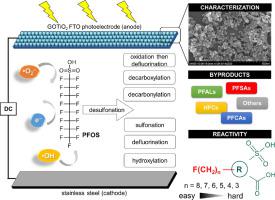Water Research ( IF 11.4 ) Pub Date : 2021-10-26 , DOI: 10.1016/j.watres.2021.117805 Jheng-Sian Yang , Webber Wei-Po Lai , Angela Yu-Chen Lin

|
The global distribution and environmental persistence of perfluoroalkyl acids (PFAAs) has been considered a critical environmental concern. In this work, we successfully fabricated a graphene oxide-titanium dioxide (GOTiO2) photoelectrode for perfluorooctane sulfonate (PFOS) degradation in a photoelectrochemical (PEC) system. The results reveal that a 5 wt.% GOTiO2 anode possesses the optimal PEC performance, with a band gap (Eg) of 2.42 eV, specific surface area (SBET) of 72.6 m2 g−1 and specific capacitance (Cs) of 4.63 mF cm−2. In the PEC system, PFOS can be efficiently removed within 4 h of reaction time, with a pseudo-first-order rate constant of 0.0124 min−1, under the optimized conditions of current density = 20 mA cm−2, electrode distance = 5 mm, solution pH = 5.64, [PFOS]0= 0.5 µM and NaClO4 electrolyte concentration = 50 mM. The electron transfer pathway, hydroxyl radicals and superoxide radicals are all responsible for PFOS decomposition/transformation. New degradation pathways were identified; a total of 25 PFOS byproducts are reported in this work; and perfluoroalkane sulfonates (PFSAs), perfluorinated aldehydes (PFALs) and hydrofluorocarbons (HFCs) were identified for the first time. PFOS degradation involves the desulfonation pathway as the first step, followed by oxidation and subsequent defluorination, decarboxylation, decarbonylation, sulfonation, defluorination and hydroxylation. The results from this work also show that the reactivity of PFAAs is related to their carbon chain length, with shorter-chain PFAAs exhibiting a lower degradation rate. In a PFAA mixture, a decline in the degradation rate was observed for the shorter-chain-length PFAAs, suggesting stronger competitive inhibition and indicating stronger environmental recalcitrance during the treatment process.
Novelty statement: Although many efforts have been made to identify perfluorooctane sulfonate (PFOS) degradation byproducts, previous studies were only able to identify byproducts that are related to perfluorinated carboxylic acids (PFCAs). This is the first study to elucidate the new PFOS degradation pathway; furthermore, this is the first report to identify byproducts containing sulfonate groups (perfluoroalkane sulfonates, PFSAs), aldehyde groups (perfluorinated aldehydes, PFALs), and hydrofluorocarbons (HFCs). This study further systematically explores how perfluoroalkyl acid (PFAA) degradation may be affected in the mixture system: shorter-chain-length PFAAs suffer stronger competitive inhibition in the photoelectrochemical (PEC) system. By utilizing the graphene oxide-titanium dioxide (GOTiO2) photoelectrode fabricated in this work, PFOS can be successfully decomposed during the PEC process for the first time.
中文翻译:

使用 GOTiO2 薄膜光电极通过光电化学过程对全氟辛烷磺酸转化途径和与其他全氟烷基酸相关的竞争抑制的新见解
全氟烷基酸 (PFAA) 的全球分布和环境持久性已被认为是一个关键的环境问题。在这项工作中,我们成功地制造了氧化石墨烯-二氧化钛 (GOTiO 2 ) 光电极,用于在光电化学 (PEC) 系统中降解全氟辛烷磺酸 (PFOS)。结果表明,5 wt.% GOTiO 2阳极具有最佳的PEC性能,带隙(E g)为2.42 eV,比表面积(S BET)为72.6 m 2 g -1和比电容(Cs) 4.63 mF cm -2. 在PEC系统中,在电流密度= 20 mA cm -2,电极距离= 5的优化条件下,PFOS可以在4小时的反应时间内有效去除,伪一级速率常数为0.0124 min -1 mm,溶液 pH = 5.64,[PFOS] 0 = 0.5 µM 和 NaClO 4电解质浓度 = 50 mM。电子转移途径、羟基自由基和超氧自由基都是全氟辛烷磺酸分解/转化的原因。确定了新的降解途径;这项工作共报告了 25 种全氟辛烷磺酸副产品;以及全氟烷烃磺酸盐 (PFSA)、全氟醛 (PFAL) 和氢氟烃 (HFC) 的首次鉴定。全氟辛烷磺酸降解涉及第一步的脱磺化途径,然后是氧化和随后的脱氟、脱羧、脱羰、磺化、脱氟和羟基化。这项工作的结果还表明,PFAAs 的反应性与其碳链长度有关,较短链的 PFAAs 表现出较低的降解率。在 PFAA 混合物中,
新颖性声明:虽然已经做出许多努力来识别全氟辛烷磺酸 (PFOS) 降解副产物,但之前的研究只能识别与全氟羧酸 (PFCA) 相关的副产物。这是首次阐明新的全氟辛烷磺酸降解途径的研究;此外,这是第一份确定含有磺酸盐基团(全氟烷烃磺酸盐,PFSAs)、醛基团(全氟醛,PFALs)和氢氟烃(HFCs)的副产物的报告。本研究进一步系统地探讨了混合体系中全氟烷基酸 (PFAA) 的降解如何受到影响:较短链的 PFAAs 在光电化学 (PEC) 系统中受到更强的竞争抑制。通过利用氧化石墨烯-二氧化钛(GOTiO 2) 在这项工作中制造的光电极,PFOS 首次在 PEC 过程中被成功分解。











































 京公网安备 11010802027423号
京公网安备 11010802027423号